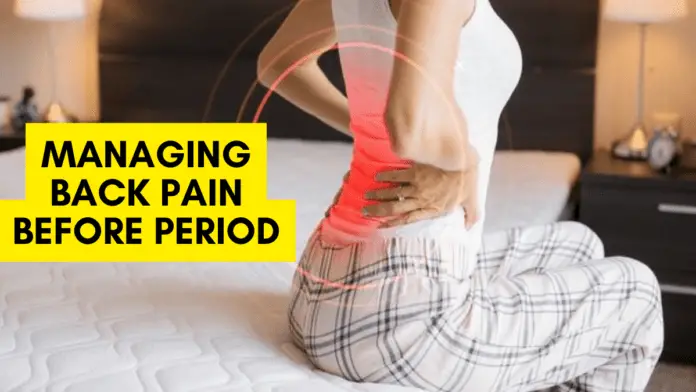
Back pain before period can be incredibly uncomfortable and disruptive to everyday life. While the exact cause of premenstrual back pain is unknown, hormonal changes and physical shifts in the body are likely factors. Fortunately, there are several techniques and tips that can help you manage this type of discomfort. Exercise, proper posture, over-the-counter medication, heating pads, or massage therapy may all provide relief from premenstrual back pain. In addition to understanding how each technique works and its potential benefits, it’s important to consider any drawbacks or precautions associated with these approaches. This article will offer practical advice on how to choose the right approach for your individual needs as well as create a personalized plan for managing premenstrual back pain.
Reasons for Back Pain Before Period
Hormonal Changes
Hormonal changes are one of the most commonly cited reasons for back pain before period. As estrogen and progesterone levels drop leading up to menstruation, it can cause muscles in the pelvic area to contract and this contraction can result in back pain. This type of pain is often described as a dull ache or cramping.
Physical Changes
Another factor that can contribute to back pain before your period is physical changes in your body. Your uterus may swell, which shifts the balance of muscles and ligaments in your lower back. This shift can cause tension, leading to pain in the lower back and hips. Additionally, as the uterus swells, it can put pressure on nerve endings. This pressure can also result in back pain before periods.
Managing Back Pain Before Your Period: Tips and Techniques
Fortunately, there are several techniques and tips that you can use to manage premenstrual back pain. Exercise, proper posture, over-the-counter medication, heating pads, or massage therapy may all provide relief from premenstrual back pain.
1. Exercise

Engaging in low-impact exercises like stretching, yoga, and walking can help relieve the tension in your lower back muscles and ligaments that contribute to premenstrual back pain. Additionally, exercise releases endorphins, which can help reduce the perception of pain. It’s important to note that while exercise can be beneficial for managing premenstrual back pain, it’s important to avoid high-impact exercises like running during this time as they may increase the discomfort you experience.
2. Proper Posture

Maintaining proper posture is also important for managing premenstrual back pain. Slouching can put strain on the muscles, joints, and ligaments in your lower back, exacerbating premenstrual discomfort. Instead, it’s important to be mindful of your posture throughout the day and ensure that you are sitting or standing correctly.
3. Over-the-Counter Medication
In some cases, over-the-counter medications can help reduce back pain before period. Nonsteroidal anti-inflammatory drugs (NSAIDs) like ibuprofen and naproxen can help reduce inflammation and alleviate discomfort. However, it’s important to be mindful of any potential side effects associated with these medications.
4. Heating Pads

Applying a heating pad or hot water bottle to the affected area can also help reduce premenstrual back pain. The heat helps relax muscles and ligaments in your lower back, relieving the tension that contributes to discomfort in the area. It’s important to note that too much heat can actually aggravate the pain, so it’s important to find a balance that works for you.
5. Massage Therapy

Massage therapy is another technique that may help alleviate your back pain before period. Massage helps relax tense muscles and ligaments in your lower back, relieving some of the strain and tension that can contribute to premenstrual back pain. Additionally, massage helps reduce stress and increase circulation, which can also ease the perception of discomfort. It’s important to note that it’s best to find a qualified therapist for massage therapy in order to ensure optimal results.
Read: Back pain 5 Days Before Period? Here’s How to Relieve Back Pain
Creating a Personalized Plan: Choosing the Right Approach for You
When it comes to managing premenstrual back pain, there is no one-size-fits-all approach. It’s important to find the right balance of techniques and tips that work best for you and your individual needs. In some cases, a combination of approaches may provide the most relief, while in other cases, one particular approach may do the trick. Additionally, it’s important to be mindful of any potential drawbacks or precautions associated with each technique and choose an approach that best suits your needs. With the right combination of techniques, you can create a personalized plan for managing premenstrual back pain and providing relief from discomfort during this time.
Conclusion
Back pain before a period can be uncomfortable and make it difficult to go about your day-to-day activities. Fortunately, there are several techniques and tips that you can use to manage your premenstrual back pain. Exercise, proper posture, over-the-counter medication, heating pads, or massage therapy may all provide relief from premenstrual back pain. It’s important to be mindful of any potential drawbacks or precautions associated with each technique and create a personalized plan that best suits your individual needs. With the right combination of approaches, you can help alleviate premenstrual back pain and get through your period in comfort.
FAQ
Why does my back hurt before my period?
Your back may hurt before your period due to a variety of factors, including hormonal changes, physical changes and increased levels of stress. Hormonal changes can act on the body’s tissues as well as the spine, which can lead to tension and discomfort in the lower back. During premenstrual syndrome (PMS), fluid retention can also cause pain in this area. Additionally, some people experience psychological distress or an increase in stress during their cycle which can contribute to premenstrual back pain. By employing various techniques such as exercise, proper posture, over-the-counter medication, heating pads or massage therapy you may be able to alleviate these symptoms and provide yourself with relief from discomfort during this time. It’s important to find a personalized solution that works for you and create a plan that best suits your individual needs.
How many days before period does back pain start?
Back pain before your period can start a few days to as early as a week or two prior. It is most common for women experience the onset of premenstrual back pain about two weeks before the start of their period, although this can vary from woman to woman. Back pain may be caused by hormonal changes such as higher levels of progesterone, physical changes such as fluid retention, and psychological distress or increased levels of stress. It’s important to find a personalized plan that suits your individual needs to help manage the discomfort associated with premenstrual back pain.
Why do I have cramps and back pain but no period?
There are a number of potential reasons why you may experience cramps and back pain but no period. One possibility is that you are pregnant. If this is the case, it is important to make an appointment with your doctor to confirm your pregnancy and begin receiving prenatal care. Other potential causes of premenstrual-like symptoms such as cramps and back pain but no period include ovarian cysts, endometriosis, uterine fibroids, or a hormonal imbalance. It is important to speak with your doctor if you are experiencing these symptoms in order to determine the underlying cause. In some cases, treatment may be necessary in order to alleviate your symptoms.
Also Read: Period-Like Pain During Pregnancy: Causes and Treatments













[…] Read: Managing Back Pain Before Period: Tips and Techniques […]